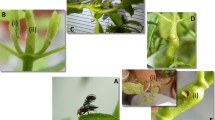Abstract
Rearing techniques and results of preliminary host range tests are reported forHadena perplexa (Denis & Schiffermuller) (Lep.: Phalaenidae) a candidate biocontrol agent against the weed bladder campion,Silene vulgaris (Moench) Garcke, in Manitoba, Canada. In the laboratory, it was necessary to pipette a 15% honey solution in water into the flowers as food for the adult moths. When reared singly to avoid cannibalism, 56% of the 1st instar larvae developed to pupae. Larvae fed on a natural diet for 10 days can then be reared on either one of 2 artificial diets. Choice oviposition tests and no-choice larval feeding tests were conducted with plant species closely related toS. vulgaris in the generaSilene, Dianthus, Gypsophila, Lychnis, Saponaria. Species in 4 of 5 of these genera were accepted for oviposition, and species in all 5 genera supported the development of 1st instar larvae to the pupal stage.H. perplexa should not be introduced into Canada.
Résumé
Des techniques d'élevage et les résultats des tests préliminaires de la gamme d'hôte sont présentés pourHadena perplexa (Denis & Schiffermuller) candidat possible pour la lutte biologique contre la silène enfléeSilene vulgaris (Moench) Garcke, mauvaise herbe du Manitoba. En laboratoire, une solution de 15% miel-eau fut placée dans les fleurs comme aliment pour les phalènes adultes. Lorsque elles sont élevées individuellement pour éviter le cannibalisme, 56% des larves du 1er stade se sont développées en pupes. Des larves nourries d'une alimentation naturelle pendant 10 jours peuvent être élevées par la suite sur deux nourritures artificielles. Des essais de préférence d'oviposition avec choix et d'alimentation sans choix avec de multiples plantes voisines deS. vulgaris appartenant aux genresSilene, Dianthus, Gypsophila, Lychnis, Saponaria, ont montré que des espèces de 4 des 5 genres furent acceptées pour l'oviposition. Aussi, des larves du 1er stade se développèrent jusqu'à la pupe sur des espèces appartenant aux 5 genres.H. perplexa ne devrait pas être introduit au Canada.
Similar content being viewed by others
References
Ball, B. (Ed.). — 1985. Ball Redbook. 14th edition. Greenhouse growing. —Reston Publishing Co., Reston. XIV+720 pp.
Bot, J. — 1967. An artificial rearing medium for three noctuids of economic importance belonging to the genusSpodoptera [Lepidoptera]. —J. Entomol. Soc. sth. Afr., 29, 157–160.
Bretherton, R. F., Goater, B. &Lorimer, R. I. — 1979.Noctuidae (120–278). In: The moths and butterflies of Great Britain and Ireland. Vol. 9.Sphingidae-Noctuidae. Noctuinae andHadeninae (J. Heath &A. M. Emmet, ed.) —Blackwell Scientific & Curwen Press, London, 288 pp.
Dunn, P. H. — 1978. Shorthcomings in the classic tests of candidate insects for the biocontrol of weeds. pp. 51–56. In:Proc. IV int. Symp. biol. Control weeds (Univ. Florida) (1976).
Forster, W. &Wohlfahrt, T. A. — 1971. Die Schmetterlinge Mitteleuropas. Eulen [Noctuidae]. — IV.Franckh'sche Verlagshandlung, Stuttgart, VII+329 pp.
Friedrich, E. — 1975. Handbuch der Schmetterlingszucht. Europäische Arten —Franckh'sche Verlagshandlung, Stuttgart, 186 pp.
Johnson, E. — 1982. Bladder Campion. A potential target weed for biocontrol in Manitoba. pp. 21–25. In: Biocontrol of Weeds Workshop. —Regina, Saskatchewan.
Lawton, F. R. — 1982. Selection of agents for the biological control of weeds. pp. 57–56. In: Biocontrol of Weeds Workshop. —Regina, Saskatchewan.
Myers, A. A. — 1968a. The diet of theHadena rivularis Fab. [Lep.: Hadeninae] group of species. —Entomologist, 101, 36–37.
Myers, A. A. — 1968b. The diet ofHadena rivularis Fab. [Lep.: Hadeninae] group of species. —Entomologist, 101, 147–149.
Shorey, H. H. &Hale, R. L. — 1965. Mass-rearing of the larvae of nine noctuid species on a simple artificial medium. —J. Econ. Entomol., 58, 522–524.
Author information
Authors and Affiliations
Rights and permissions
About this article
Cite this article
Peschken, D.P., Derby, J.L. Evaluation ofHadena perplexa [Lepidoptera: Phalaenidae] as a biocontrol agent of bladder campionSilene vulgaris [Caryophyllaceae] in Canada: Rearing and host specificity. Entomophaga 35, 653–657 (1990). https://doi.org/10.1007/BF02375099
Received:
Accepted:
Issue Date:
DOI: https://doi.org/10.1007/BF02375099




